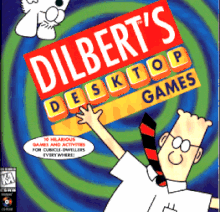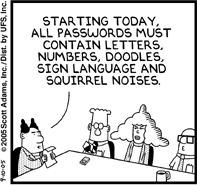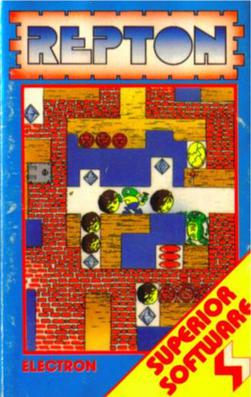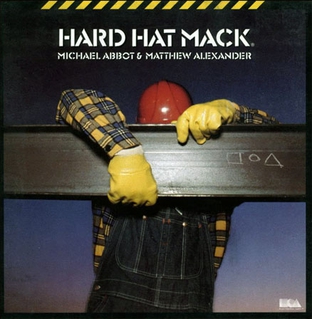| Dilbert's Desktop Games | |
|---|---|
 | |
| Developer(s) | Cyclops Software |
| Publisher(s) | DreamWorks Interactive |
| Platform(s) | Windows |
| Release | |
| Genre(s) | Puzzle, action |
| Mode(s) | Single-player |
Dilbert's Desktop Games is a collection of Dilbert -related games for Windows.
| Dilbert's Desktop Games | |
|---|---|
 | |
| Developer(s) | Cyclops Software |
| Publisher(s) | DreamWorks Interactive |
| Platform(s) | Windows |
| Release | |
| Genre(s) | Puzzle, action |
| Mode(s) | Single-player |
Dilbert's Desktop Games is a collection of Dilbert -related games for Windows.

Completing a particular goal in each of the first seven games above awards a component, such as a microchip, capacitor, or piece of wire. Once every component has been found, the player can enter his/her name on a printable certificate award that lists the total amount of time spent playing the games.
In Spain, Sergio Zazo of the magazine PC Manía gave Dilbert's Desktop Games a score of 81 out of 100. He wrote that it provided "great moments of fun". [2]

Dilbert is an American comic strip written and illustrated by Scott Adams, first published on April 16, 1989. It is known for its satirical office humor about a white-collar, micromanaged office with engineer Dilbert as the title character. It has led to dozens of books, an animated television series, a video game, and hundreds of themed merchandise items. Dilbert Future and The Joy of Work are among the best-selling books in the series. In 1997, Adams received the National Cartoonists Society Reuben Award and the Newspaper Comic Strip Award for his work. Dilbert appears online and as of 2013 was published daily in 2,000 newspapers in 65 countries and 25 languages.

A graphical user interface, or GUI, is a form of user interface that allows users to interact with electronic devices through graphical icons and visual indicators such as secondary notation. In many applications, GUIs are used instead of text-based UIs, which are based on typed command labels or text navigation. GUIs were introduced in reaction to the perceived steep learning curve of command-line interfaces (CLIs), which require commands to be typed on a computer keyboard.

The history of the graphical user interface, understood as the use of graphic icons and a pointing device to control a computer, covers a five-decade span of incremental refinements, built on some constant core principles. Several vendors have created their own windowing systems based on independent code, but with basic elements in common that define the WIMP "window, icon, menu and pointing device" paradigm.

A desktop computer is a personal computer designed for regular use at a stationary location on or near a desk due to its size and power requirements. The most common configuration has a case that houses the power supply, motherboard, disk storage ; a keyboard and mouse for input; and a monitor, speakers, and, often, a printer for output. The case may be oriented horizontally or vertically and placed either underneath, beside, or on top of a desk.

A laptop computer or notebook computer, also known as a laptop or notebook, is a small, portable personal computer (PC). Laptops typically have a clamshell form factor with a flat-panel screen on the inside of the upper lid and an alphanumeric keyboard and pointing device on the inside of the lower lid. Most of the computer's internal hardware is fitted inside the lower lid enclosure under the keyboard, although many modern laptops have a built-in webcam at the top of the screen, and some even feature a touchscreen display. In most cases, unlike tablet computers which run on mobile operating systems, laptops tend to run on desktop operating systems, which were originally developed for desktop computers.

Pump It Up is a music video game series developed and published by Andamiro, a South Korean arcade game producer.

In the Groove is a rhythm game developed & published by Roxor Games, and is the first game in the In the Groove series. The game was shown in an official beta-testing preview on July 9, 2004, and was officially released in arcades around August 30, 2004. A PlayStation 2 port of In the Groove was released on June 17, 2005, by RedOctane.

A wallpaper or background is a digital image used as a decorative background of a graphical user interface on the screen of a computer, smartphone or other electronic device. On a computer, wallpapers are generally used on the desktop, while on a mobile phone they serve as the background for the home screen. Though most devices include a default background image, modern devices usually allow users to manually change the background image.

Repton is a video game originally developed by 16-year-old Briton Tim Tyler for the BBC Micro and Acorn Electron and released by Superior Software in 1985. The game spawned a series of follow up games which were released throughout the 1980s. The series sold around 125,000 copies between 1985 and 1990 with Repton 2 selling 35,000 itself. The games have since been remade for several modern systems, including iRepton for the iPhone / iPod Touch in 2010, and Android Repton 1, Android Repton 2 and Android Repton 3 from 2016 to 2018.

Hard Hat Mack is a platform game developed by Michael Abbot and Matthew Alexander for the Apple II which was published by Electronic Arts in 1983. Ports for the Atari 8-bit computers and Commodore 64 were released simultaneously. It is part of the first batch of five games from Electronic Arts, and the company called it out as "truly EA's first game." Versions for the Amstrad CPC and IBM PC compatibles followed in 1984.

Online Bomberman was a 2003 online game of the Bomberman franchise developed by MGAME Corporation and Hudson Soft, and was released for Microsoft Windows in Japan, South Korea, Taiwan, Hong Kong and Macau. All servers have been permanently shut down. However, there is a fan-based version.
Microsoft Plus! is a discontinued commercial operating system enhancement product by Microsoft. The last edition is the Plus! SuperPack, which includes an assortment of screensavers, themes, and games, as well as multimedia applications. The Microsoft Plus! product was first announced on January 31, 1994, under the internal codename "Frosting". The first edition was an enhancement for Windows 95, Windows 95 Plus!
Microsoft Gadgets are lightweight single-purpose applications, or software widgets, that can sit on a Microsoft Windows user's computer desktop, or are hosted on a web page. According to Microsoft, it will be possible for the different types of gadgets to run on different environments without modification, but this is currently not the case.

Windows SideShow was a feature by Microsoft introduced in Windows Vista to supply information such as e-mail, instant messages, and RSS feeds from a personal computer to a local or remote peripheral device or display. SideShow was intended to enhance the Windows experience by enabling new mobility scenarios for the Windows platform and by providing power saving benefits as part of Microsoft's broader efforts regarding a mobile initiative.

Home Alone is the title of several tie-in video games based on the 1990 film of the same name written by John Hughes. Versions were released for the Nintendo Entertainment System, Game Boy, Super Nintendo Entertainment System, Master System, Sega Genesis, Game Gear, Amiga, and MS-DOS platforms. The games were released between 1991 and 1992, each with different gameplay.

A personal computer, often referred to as a PC, is a computer designed for individual use. It is typically used for tasks such as word processing, internet browsing, email, multimedia playback, and gaming. Personal computers are intended to be operated directly by an end user, rather than by a computer expert or technician. Unlike large, costly minicomputers and mainframes, time-sharing by many people at the same time is not used with personal computers. The term home computer has also been used, primarily in the late 1970s and 1980s. The advent of personal computers and the concurrent Digital Revolution have significantly affected the lives of people.

Skiing is a video game cartridge for the Atari 2600. It was authored by Bob Whitehead and released by Activision in 1980. It's one of the first video games developed by Activision.

OnLive was a provider of cloud virtualization technologies based in Mountain View, California. OnLive's flagship product was its cloud gaming service, which allowed subscribers to rent or demo computer games without installing them. Games were delivered as streaming video rendered by the service's servers, rather than running on the local device. This setup allowed the games to run on computers and devices that would normally be unable to run them due to insufficient hardware. OnLive also enabled other features such as the ability for players to record game-play and to spectate.

StepManiaX is a rhythm game developed and published by Step Revolution, a studio formed by former developers of In the Groove, ReRave, and Pump It Up Pro. It is considered a spiritual successor to the In the Groove series. The name is a nod to the legacy of the open-source simulator StepMania, as many of the original StepMania developers were involved with the project. StepManiaX is derived from the same codebase, with modifications made to support the new game types, lights, touch support, connectivity, and the custom Android operating system and hardware that dedicated units run on.
Released: 10/97